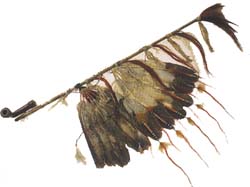
 |
Calumet pipe from Lewis & Clark expedition, 1804-1805 (probably Mandan). (photo by Hillel Burger) |
There remains no more, except to speak of the Calumet. There is nothing more mysterious or more respected among them. . . . It seems to be the God of peace and of war, the Arbiter of life and of death. (Jacques Marquette, 1674)![]()
The calumet was a tobacco pipe, highly revered by the Illinois, which could be used to end disputes, strengthen alliances, and ensure peaceful relationships with strangers. The pipe's bowl was carved from a red stone, called Catlinite, which was attached to a wooden stem. The stem was decorated with the heads and necks of various birds and with large red and green feathers.
The Calumet Dance was an important Illinois ceremony performed to strengthen peace with other tribes, to unite themselves for war, or at times of public celebration. Participants would form a circle around a large painted mat and the principal dancer would dance with the calumet, keeping time with the songs being sung. Then a drum would sound, beginning a mock battle between the calumet and an armed warrior. At the end of the dance, the chief would present the calumet to the honored guests as a token of everlasting peace.![]()
|
|
Copyright © 2000 Illinois State Museum